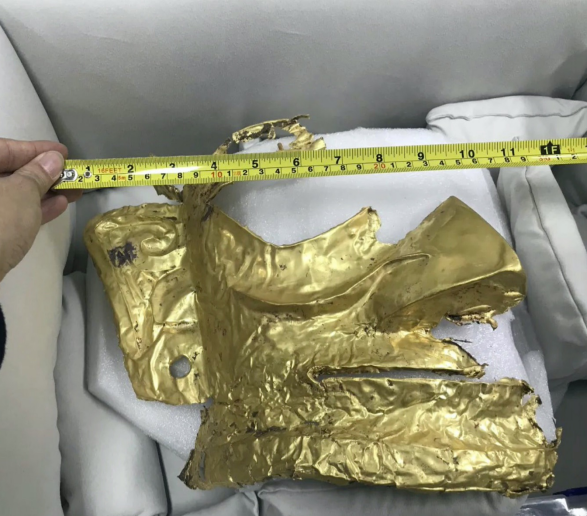
Gold mask unearthed from No.5 pit
Acting by the arrangements of the Sichuan Provincial Cultural Relics and Archaeology Research Institute, the School of Archaeology and Museology(SAM) participated in the excavation at the Sanxingdui Archaeological Site in December 2020.
In order to meet the needs of archaeological excavation and research in Sanxingdui in the new period, SAM has established a Sanxingdui archaeological team made up of 15 teachers from different research fields. The team joined hands with the professionals of the Sichuan Provincial Cultural Relics and Archaeology Research Institute and unearthed the artifacts of the No 5, No. 6 and No. 7 sacrificial pits. SAM has sent altogether 21 doctoral students, master students and undergraduates to Sanxingdui for the excavation.
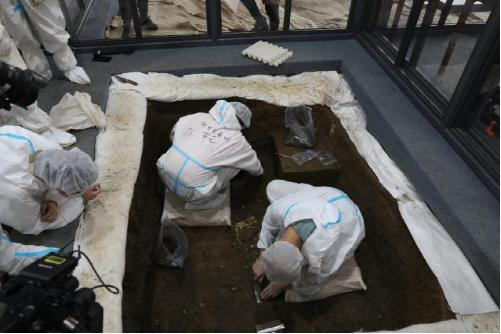
Cleaning up the gold mask in pit 5.
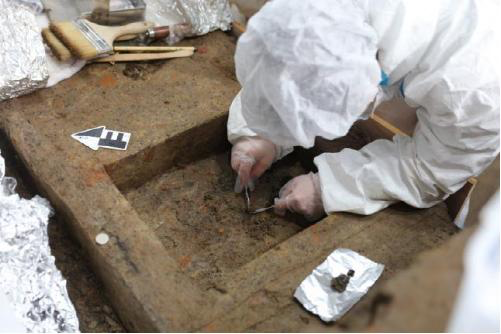
Cleaning the “wooden case” in pit 6
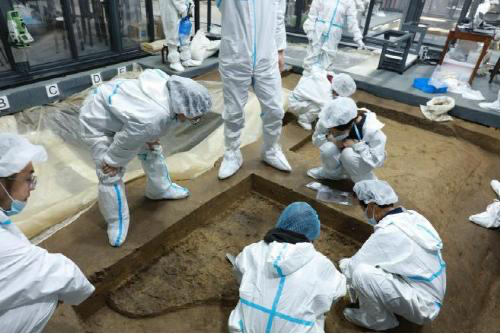
Excavation in the No. 7 pit
Archaeologists have made great progress in the excavation at Sanxingdui this time. On December 11, 2020, the archaeological team of our university arrived at Sanxingdui to participate in the excavation of the newly discovered sacrificial pits, mainly responsible for the excavation of the 5th, 6th and 7th pits. Smallest in size, pit No. 5 covers an area of only 3.5 square meters. So far, the team has unearthed many pieces of gold ware, more than 60 round gold ornaments with holes, a large number of jade tube beads and ivory ornaments.
At present, the most eye-catching gold face mask comes from pit No. 5. In January 2021, they started to carefully clean up the ruins in pit No. 5, where a large gold mask was unearthed. Besides the gold mask, the archaeologists also found a large number of elephant tusks, ivories, gold foils and pieces of gold ware, as well as some bronzes and jades. Objects that looked like "wooden case" and "wooden utensils" were found in pit No.6. The inside of the wooden case was coated with cinnabar, which is the most special among the eight pits under excavation so far. The relics fueled a great deal of speculation in the academic circle. The No. 7 pit ranks the fourth in size. Excavation started in the south of this pit on Feb. 5 2021. At present, the excavation inches to the artifacts layer. Compared with other sacrificial pits where excavation reached the artifacts, the artifacts in pit No.7 are what the archaeologists expect the most.
The excavations at Sanxingdui sacrificial pits are helpful to solve the long-standing academic problems, such as the most basic problems of age and nature. Previously, only two pits were discovered. The number has increased to eight this time. A detailed exploration of the surrounding areas helps to restore the inner space of the "temple" or "sacrificial area" at that time, and provides very important information for a complete understanding of the etiquette space, religious thought of ancient Shu culture.
CCTV, Xinhua News Agency, The Paper, Tencent.com and other mainstream media continue to cover and report the archaeological excavation of Sanxingdui sacrificial pits.
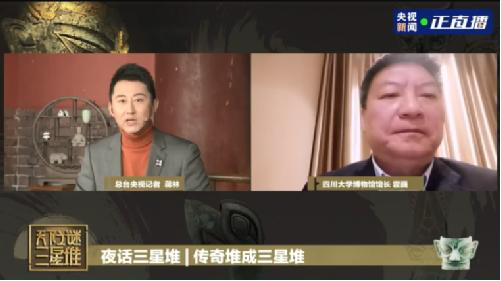
In an interview with CCTV News on March 20, Huo Wei, the curator of the Sichuan University Museum, talked about the origin of the Sanxingdui legend. "I am very happy that the team of Sichuan University, under the unified leadership of Sichuan Provincial Cultural Relics and Archaeology Research Institute, is conducting a very important archaeological work on the spot along with many domestic universities including Peking University and Shanghai University."
Huo Wei further said that in 1986, he himself, Chen De'an and Chen Xiandan guided an excavation team of students to practice at Sanxingdui. As a teaching assistant, he participated in the excavation of Sanxingdui. Huo also introduced the connection between the unearthed cultural relics from Sanxingdui and the collections in the Sichuan University Museum.
Report link:https://zhibo.sina.com.cn/wb/114425
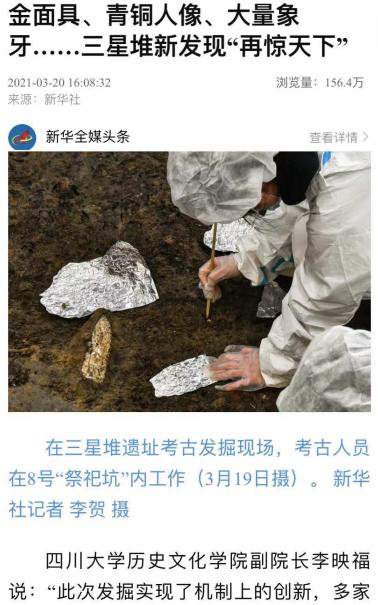
In an interview with Xinhua News Agency on the same day, Li Yingfu, vice dean of the School of History and Cultures (Tourism), said: "This excavation is innovative in mechanism, with the participation of many institutions. They formed a high-level excavation team, built a multidisciplinary research team covering a wide variety of disciplines, and streamlined the seamless connection between on-site archaeological excavation and cultural relics protection.".
Report link:https://xhpfmapi.zhongguowangshi.com/vh512/share/9845246?isview=1&homeshow=1&newstype=1001
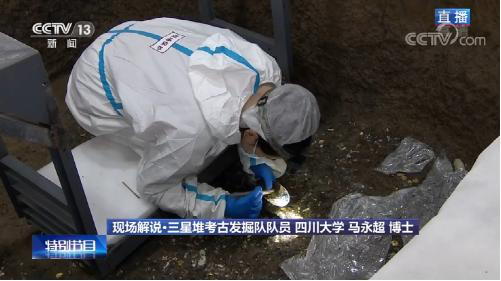
The March 20 CCTV broadcast shows Dr. Ma Yongchao of SAM, the person in charge of pit No. 5, is unearthing gold foils in pit No. 5 of the Sanxingdui Archaeological Site.The correspondent explained that Ma kneeled on the operating platform, painstakingly cleaning up the mud and other substances attached to the round gold foil.
Report link:https://tv.cctv.com/live/cctv13/index.shtml?spm=C28340.P2qo7O8Q1Led.S87602.81&stime=1616216400&etime=1616223600&type=lbacks
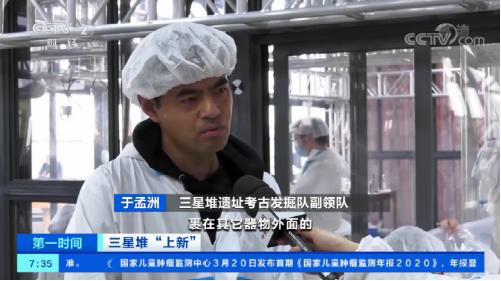
A large number of gold artifacts have been unearthed at the Sanxingdui site, among which a unique gold mask is the most popular. In an interview with CCTV on March 21, Yu Mengzhou, lieutenant captain of the Sanxingdui archaeological excavation team and professor of SAM, noted: "It has many wrinkles. Then we make guesses. Some people guess, for example, it may be the gold mask on the bronze head; some guess it may be wrapped on other objects, and some others guess it might be the gold foil wrapped on the gold stick."
Report link:https://tv.cctv.com/live/cctv2/index.shtml?spm=C28340.P2qo7O8Q1Led.S87602.58&stime=1616281200&etime=1616288550&type=lbacks
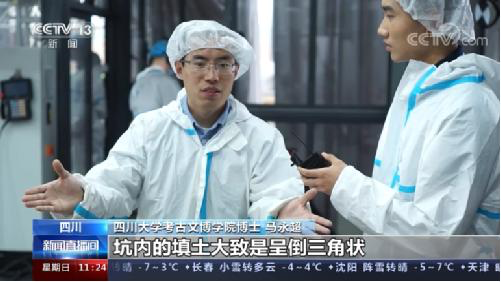
A March 21 CCTV live broadcast reportedthat the archaeologists used the structure characteristics of No.7 and No.8 sacrificial pits to decipher ancient Shu people’s sacrifice pits in Sanxingdui. Ma Yongchao said in an interview: "The filling in the pit is roughly in an inverted triangle shape, and the surrounding soil is filled in from the periphery to the middle."
Report link:https://tv.cctv.com/live/cctv13/index.shtml?spm=C28340.P1dzdfA9CsHZ.E1oxZyG629bH.168&stime=1616295600&etime=1616299200&type=lbacks
David C. Graham (1884-1962): Doctor of Anthropology, University of Chicago; served as professor and curator of the Museum of West China Union University (the predecessor of the Sichuan University Museum) 1932-1948,
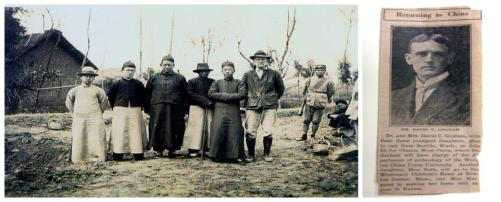
SCU’s archaeologists have participated in many excavations at Sanxingdui. As early as 1934, Prof. David C. Graham and Prof. Lin Mingheng of the Museum of West China Union University (now the Sichuan University Museum) carried out an archaeological excavation in Yueliangwan of Sanxingdui. They excavated more than 600 pieces of jade, stone and pottery, which marked the archaeological advent of the "Sanxingdui culture”. In 1935, Prof. Graham published “A Brief Report on the Excavation of Hanzhou” in Issue 6 of the Journal of the West China Frontier Research Society. He gave a detailed introduction to the archaeological excavation at Yueliangwan. This is a representative work of the early study of Sanxingdui culture.
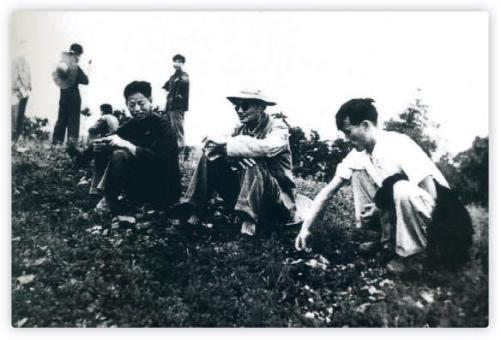
In 1963, Mr. Feng Hanji (middle) and Mr. Zhang Xunliao conducted an archaeological investigation at Sanxingdui.
After the construction of Bao-Cheng railway started in 1953, Feng Hanji led the Department of History of Sichuan University and the Sichuan Provincial Museum to archaeological investigations and trial excavations in Sanxingdui area for many times, and they made new discoveries incessantly. In 1960, Zhang Xunliao taught General Theory of Archaeology for Class 1957 history majors. During this period, he guided students to Sanxingdui for a short-term archaeological investigation. In June 1961, Zhang Xunliao, Ma Jixian led history majors of Class 1958 to an archaeological survey at the Zhongxing (Sanxingdui) site of Guanghan. The survey data and research results were published in the 11th issue of Cultural Relics in 1961. In 1963, the Sichuan Provincial Museum and the Archaeology major of the Department of History, SCU formed a joint archaeological team to conduct an official archaeological excavation in Yueliangwan.
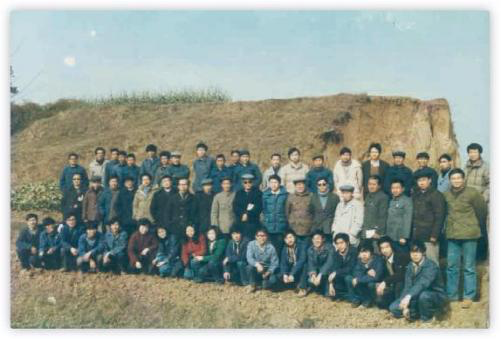
The Class 1984 got some practice at Sanxingdui of Guanghan.(Photo taken in March 1986).
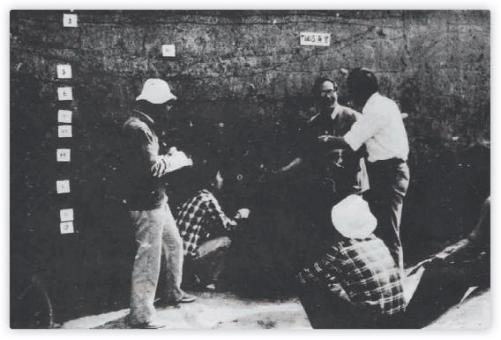
The Class 1984 archaeological practice team discussed the strata at the site of Sanxingdui. The person who leans on the wall is Lin Xiang. (Photo taken in 1986)
In March, 1986, SCU teachers of Lin Xiang, Huo Wei and Li Yongxian led the Class 1984 undergraduates of Archaeology to practice in Guanghan, and conducted a large-scale excavation at the Sanxingdui Archaeological Site. The excavation took place within dozens of meters from pits No. 1 and No. 2, which were discovered later. The biggest harvest was the discovery of rich cultural layers and pottery groups, which substantially enhanced the understanding of the cultural connotation of Sanxingdui, and has very important academic significance.
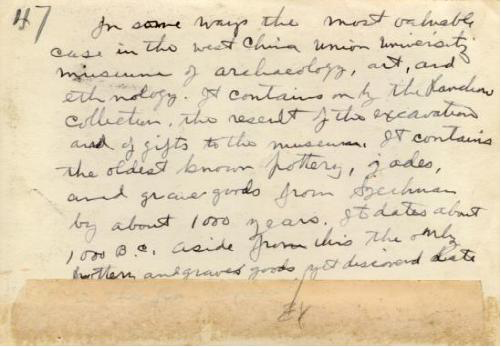
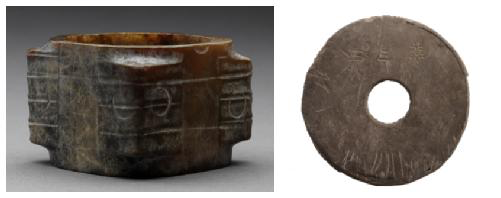
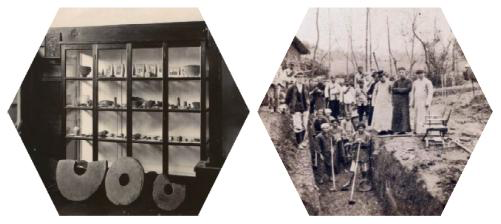
Unearthed cultural relics and old archives from Sanxingdui in Sichuan University Museum
There are more than 200 pieces of Sanxingdui cultural relics in the Sichuan University Museum, which are mainly divided into three categories: pottery, jade and stone tools. The pottery was excavated in Yueliangwan of Guanghan in 1934. The earthenware is ceramic fragments, about 100 pieces altogether. There are about 10 pieces of jade work, most of which are collected. In addition, there are about 100 stone tools, either excavated in 1934 or collected over time.
The Chinese names begin with family name in this report.
